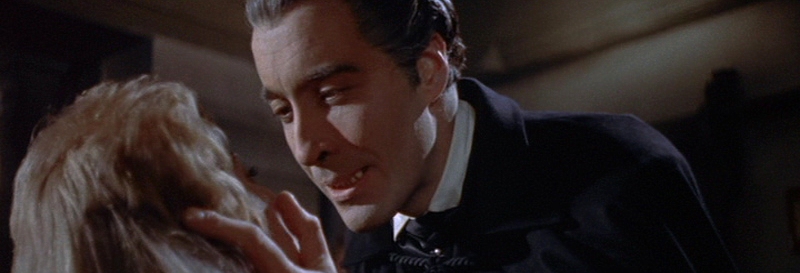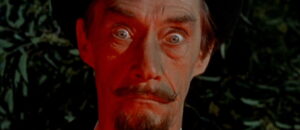A couple months ago, our special contributor Adam wrote up a review of ‘The Hammer Vault’, a book that details the history of the legendary British movie studio, Hammer Films. Reading that review forced me to admit that I’d never actually seen a film from the studio – well, none of its classics, anyway. (I’d only seen the very recent ‘Let Me In‘.) I decided to rectify that oversight, only to realize that few of the studio’s movies are currently available on Blu-ray. VUDU, however, came to the rescue with one of Hammer’s signature titles, ‘Horror of Dracula’, directed by Terence Fisher and starring the duo of Christopher Lee and Peter Cushing.
Although Hammer Films had been producing movies, mostly period costume dramas, since the early 1930s, the studio didn’t truly forge a unique identity for itself until the birth of so-called “Hammer Horror” in the 1950s, starting with Nigel Kneale’s sci-fi thriller ‘The Quatermass Xperiment’ in 1955. The most popular of these were the series of films centered around the iconic Gothic literary characters Frankenstein and Dracula. The 1958 ‘Horror of Dracula’ was the first in the vampire cycle, and made a superstar out of Christopher Lee, who had also played the Monster in the previous year’s ‘The Curse of Frankenstein’.
‘Horror of Dracula’ is a loose adaptation of Bram Stoker’s novel that takes many liberties with its source. Similar to the book, the film starts with Jonathan Harker (John Van Eyssen) traveling to Castle Dracula in Romania for business. (Never does the movie refer to the location as Transylvania.) However, this Harker is not a law clerk, but a librarian, engaged by the Count to sort out his book collection. This particular change doesn’t really lead to anything or go anywhere, so I’m at a loss to explain why it was imposed. But that’s nothing compared to the next plot twist. Soon after arriving, Harker reveals that he’s not a librarian either, but rather the assistant of famed monster hunter Dr. Van Helsing, sent undercover on a mission to kill the vampire!
That’s quite a drastic divergence from the source material. Harker makes his way to the crypt in Dracula’s basement and sets about on his task, but makes the boneheaded mistake of staking the Count’s buxom bride first, thus giving Dracula time to wake up and get the jump on him. Later, the erudite Van Helsing (Peter Cushing) arrives at the castle to find his protégé, only to realize that he’s too late and the vampire has fled – though not to England, but to Bavaria for some reason. (Naturally, most of the cast speak English with British accents.)
From there, further changes entail a lot of consolidation and repurposing of characters. We learn that Harker’s fiancée was not Mina, but Lucy. Mina, meanwhile, is the wife of Arthur Holmwood (Michael Gough), who is in turn Lucy’s brother. The jumbling of these relationships will mainly be notable to fans of the book. While the changes seem to serve little purpose, they aren’t detrimental to the film as a film. Other characters such as Dr. Seward, Quincey Morris and Dracula’s acolyte Renfield have been streamlined out of the narrative.
As in Stoker’s original telling, Dracula turns Lucy and seduces Mina. That much remains the same, but the rest of the story has been greatly condensed and simplified. Basically, what it boils down to is that Van Helsing and Holmwood team up to take care of the Lucy situation and kill Dracula, then chase the vampire back to his castle.
Hammer’s films were famous for their ornate production design. While certainly elaborate, the sets look pretty stagy. The action is also frequently stodgy and blandly staged. I hate to use a word like “dated,” but director Fisher’s attempts to create atmosphere are pretty old-fashioned in approach, mostly involving a lot of fog machines and creepy music. The film’s bloody violence was notable in its day, but seems quite tame by modern standards. While the young and dashing Lee has a magnetic screen presence, the movie doesn’t use him nearly enough. Dracula spends far too much of the running time off camera. The vampire also doesn’t wind up being particularly dangerous to the male characters, who scuffle with and dispatch him without too much fuss.
(Forgive the plot spoilers, but… c’mon, I can’t be held responsible if you don’t know the basic story of ‘Dracula’ by now. It’s been made into about 500 different movies. Also, Lee returned as Dracula in a series of sequels, so that should tell you how definitive his character’s fate is here.)
None of what I’ve written above should suggest that ‘Horror of Dracula’ is a bad movie. I actually had quite a lot of fun watching it. Nonetheless, I suspect that younger viewers will probably label the film “cheesy” and dismiss it. Such are the foibles of youth.
VUDU’s 1080p HDX streaming version looks pretty terrific, surprisingly so. A Warner Bros. logo suggests that this comes from a cable broadcast master that made the rounds on the now-defunct Monsters HD network a few years ago. (I don’t believe Warner has distribution rights anymore.) The picture is presented in a 1.78:1 transfer. It should be 1.66:1, but the difference isn’t drastic enough to be a deal breaker. The credit text is very crisp and detail throughout is quite good. Film grain is present; it’s neither overwhelming nor smeared away with DNR. Some minor dirt and hair on the film elements aren’t terribly distracting. The image seems a bit too bright for a horror movie, but I’m not familiar enough with the film to know how accurate that is. Blood is bright red and looks kind of fakey, but that may have been a censorship requirement of the day. Colors otherwise seem accurate, if a little bland. All in all, it’s a very satisfying high-def experience for a film of this age.
The Dolby Digital mono soundtrack is less impressive, unfortunately. It’s very flat, with harsh volume swings and no low end. Still, it’s listenable.
While VUDU rentals don’t come with extras, per se, the service often provides free preview trailers when available. The one for this is very corny. It also looks like a standard-def TV ad that’s been cropped and then stretched to 16:9.





EM
My favorite adaptation of the novel (which I’ve read at least a few times) is the 1931 Dracula starring Béla Lugosi. That film is about as divergent from the novel as this one is, including the musical-chairs relationships. And it may be even more stagy than this one. But it’s got some memorable performances and nifty atmosphere.
Christopher Lee, an excellent actor, is criminally underused in this Dracula (its original UK-release title, sans Horror of). But the real star here is the lurid color, which turns me off, in part because it requires lighting far too bright for this sort of tale. Although I’ve tried several times—and will continue to try—I’ve never been able to jump on the Hammer bandwagon. Probably the best example of Hammer horror in its heyday is The Asphyx, which (ahem) isn’t actually a Hammer film. But it’s got the color and the Victorian trappings. I also tip my hat to The Abominable Snowman, a bona fide Hammer film in nonlurid black & white that came out a year before Hammer’s Dracula and stars Peter Cushing.
I’m not actually trying to warn people away from this version of Dracula. It just isn’t my cup of…wine?
What are the better versions of Dracula, anyway? Murnau’s Nosferatu has an awesome take on the vampire’s look and I chuckle at its counterpart for Renfield, but I find the other humans to be too bland. George Melford’s Spanish-language Dracula, made concurrently with Tod Browning’s version starring Lugosi, is more cinematic than Browning’s; but I find its performances less compelling. John Badham’s 1979 version starring Frank Langella is stylish but occasionally descends into camp. Coppola’s is beautiful in its imaginative design and is in some ways the most faithful adaptation of the storyline, but its performances are uneven and the shoehorned “immortal romance” story fails to come together. I think there’s still room for a definitive cinematic Dracula.
EM
Oops, meant to mention Herzog’s 1979 Nosferatu. Klaus Kinski’s Count is amazing (especially in German—Herzog also lensed takes in English to make two versions of the film). This Nosferatu isn’t just a remake—it has an odd style that feels like a remake of the scenes of the original film, rather than of the whole film itself. The film’s portrayal of Dracula as a tragically lonely character is poignant but ultimately I find the film too cold and uninvolving.
JM
Francis Ford Coppola’s ‘Dracula’ hit me the right way at the right age that I can’t imagine liking another version better.
It’s like Gary Oldman drank all of my 19-year-old rage and pissed opera.
thulsadoom
I enjoy them a lot because Lee and Cushing have such screen presence, it becomes enjoyable simply watching their performances.
I’ll admit they’re certainly dated films, there’s no getting around that, but they’re enormous fun when viewed in the proper perspective as products of their time.
Some people will always view things that are more than five years old as ‘cheesy’ unfortunately. And not just youngsters! 😉 (actually, if they’re film fans, they’re more than likely some of the few who will still appreciate things).
I find oddly enough it’s middle-aged people who seem to be strangely snobby about older films, and find anything over a certain age to be ‘cheesy’ by default. Such as not watching science fiction TV shows that are more than a few years old, because ‘the effects look cheesy’. People are just plain weird sometimes… 😉
Josh Zyber
AuthorThat’s a good point, that it isn’t just kids who act this way. I know an acquaintance who refuses to watch any movie more than ten years old, because they’re too “dated” for him. Even if he liked a movie in the past, once ten years have passed, he won’t watch it anymore.
Even more bizarrely, he also refuses to watch movies that are SET more than 10 years in the past. Even a brand new movie like Hugo would be too “old fashioned” for him. It boggles my mind.
Thulsadoom
My girlfriend is a bit like that. Getting her to give Casablanca a go was tough, and I don’t think she was impressed. She couldn’t watch Babylon 5 because of the older style CGI effects, and she won’t go near the original Planet of the Apes, even though she enjoyed ROTPOTA. Logan’s Run and Forbidden Planet are no-goes, due to their aged styles…
Oddly enough, I remember when my grandmother was alive, she refused to watch anything in B&W!!
On the other hand, my niece really enjoyed The Forbidden Planet at the age of about 9! I sometimes wonder if it’s something to do with fear of ageing? In that perhaps people who are getting older don’t like to watch older TV/Films, because enjoying them somehow subconsciously links them to being of that older era? So they make up the excuse of it being ‘cheesy’ or ‘too-dated’, in order to avoid being associated with it?
Whereas younger people don’t have that (They can just enjoy things for what they are), and film fans don’t see stuff in that context… Just a theory… 😉
JM
‘Casablanca’ was so boring. I can’t see how people of any generation found that movie well-made. I only have two theories.
(1) Some old movies are considered great by default, simple because all of their competition was worse.
(2) Writing and directing and acting have evolved so much that old movies, through the lens of today, look like kindergarden art.
I don’t have a 10-year bias, but I have an R-rated bias. I have a philosophical hatred of all movies not rated R because I feel like the artists are lying about the human condition simply to triple their profit.
Josh Zyber
AuthorBarbarella was rated PG. Knowing your predilections, I suspect that you might enjoy that one.
I’m not touching your comment about Casablanca.
Ian Whitcombe
Most R-rated movies these days do not show detailed penetrative sex or accurate bullet carnage. In fact, by the cinematic standards you’ve set forward, all films should show the characters going to bathdroom or masturbating.
Such prudish filmmakers.
Thulsadoom
Casablanca boring… ahhh… I can’t say anything… The mind boggles… 😉
EM
As the saying goes, there’s no accounting for taste…or perhaps more accurately, there’s a wide variety of influences on tastes that makes accurate predictions difficult if not impossible.
The hypothesis about wishing to distance oneself from older styles, possibly to deny one’s own aging, is an interesting one. I wouldn’t be surprised if it turned out to be true, in some cases.
Sometimes it’s a matter of exposure. I made an effort to expose a friend’s children to older television, film, and video games when they were still children, before they could develop prejudices.
Another thread is that some people have a notion that art—or some arts, anyway—must be highly realistic to be valid or at least to appeal to them. Given the potential of motion-picture photography and video to capture real life with very high fidelity, this notion can very strongly inform their views of works within those particular media. I think there are a lot of variations on this, for example:
• Since technical advances permit more accurate recordings of reality and more convincing simulations of reality, newer works may be favored over older works.
• There may be low tolerance for black-and-white photography.
• There may be low tolerance for silent cinema.
• There may be low tolerance for animation.
• There may be low tolerance for genres that depict a world clearly outside our own (science fiction, fantasy, supernatural horror…).
• There may be low tolerance for genres that depict nonrealistic behavior (musicals, slapstick comedy, wuxia…).
Sometimes this penchant for realism is not so simple. The individual may approve of a work that diverges from realism, but only if it diverges wildly from it—otherwise the work may fall into an “uncanny valley” much like that discussed in animation. To stick with the animation example, maybe Looney Tunes is OK but mo-cap or rotoscoping is not. Maybe black-and-white is OK for obviously “old” movies or specialized uses but not for depictions of the everyday modern world. Maybe fantasy is OK if it’s as blatant as The Wizard of Oz or The Chronicles of Narnia but not if it’s magical realism.
I don’t recall ever hearing of a prejudice like the one Josh cites, in which one categorically avoids works set in the past. But maybe it’s a realism thing, in that the real world is the world of now.
JM
Robert Rodriguez’ $70M ‘Barbarella’ reboot had me excited until it died.
Maybe the project should go to Zack Snyder?
JM
If they made ‘Star Wars VII’ with a PG-13 cut and an NC-17 cut, which version would you buy?
Josh Zyber
AuthorIf it’s as bad as The Phantom Menace, none of the above. 🙂
JM
You don’t want to see naked Yoda fuck a Twi’lek in the ass?
Josh Zyber
AuthorDecidely not.
There’s a plethora of fan fiction available on the web, if you’re into that sort of thing. 🙂
JM
‘Iron Man’ is a sexual deviant in a murder suit.
If Favreau had shot an NC-17 cut, an honest portrayal of the lifestyle, drunken sex, inventive profanities, the wet-work of killing naughty arabs, you wouldn’t prefer that to the PG-13 popcorn version we got?
JM
Is ‘Casablanca,’ in the cinephile religion, illegal to blasphemy?
Did I just recite muslim poetry at a klan rally?
EM
It’s one thing to say you dislike a popular work. It’s another to go on and essentially state that people who disagree with your dislike are obviously defective in some way, ironically exposing your own defects—not in taste, which is subjective, but in courtesy and in the ability to imagine that other people may have perfectly legitimate tastes that are not your own.
Josh Zyber
AuthorIt’s more like saying that chocolate is repulsive, and anyone who pretends to like it is a liar.
The claim just doesn’t compute.
JM
I’m trying to say that I don’t understand why I hate arugula. I want to like it, to be like everybody else who’s respectable, but I don’t know how.
Obviously my semantics are iffy, and all of my logic is emotion based. I thought it was clear that I was recognizing my own taste as inferior.
Often I feel like I’m cinematically broken. Like Keira Knightley in ‘A Dangerous Spanking.’
Did you all just watch ‘Casablanca’ for the first time and instantly feel it as a timeless work of art?
Or is it like exercise? Do I have to watch it regularly until it works?
Thulsadoom
I can understand why everyone has different tastes… some are just more difficult to understand. 😉 So I think it’s as problematic for some of us to see how you find Casablanca boring, as you to see why we find it great. 🙂
It’s got me thinking though… I was writing a big long explanation as to why I love Casablanca, and then I realised it was getting so long, I should use it as a fun little article on my blog lol! So when I finish it, I’ll post the link (Not a shameless plug, though… honest).
As for when Casablanca grabbed me, it was from first viewing. I was in my late teens, and apart from a few old classic sci-fi movies and horror films, I wasn’t a big fan of generally older movies. I thought I’d give Casablanca a go out of curiosity because of its reputation, fully expecting to be underwhelmed by an old B&W film that was probably good for its time, but nothing more… After I’d finished watching I was just gob-smacked how great it was, and it got me watching a lot more old films. 🙂
JM
Old movies don’t work for modern audiences, I speculate, because of the emotional disconnect.
Moviegoers have a spectrum of emotional needs, based on age, race, class, sex, intellect, and social structures. We connect like magnets.
I had a friend who on first viewing was gob-smacked by Fellini’s ‘8.5.’ We were watching it together and my reaction was quite the opposite.
I first saw ‘Casablanca’ I think in 2007 on hd-dvd, and I felt nothing. Maybe that only means the emotion of the film isn’t a catharsis I need.
The only film my grandpa and I both admire is ‘The Big Lebowski.’ But we both attached to it with entirely different emotions.
Which 2011 films will the youth of 2071 still hold as timeless art?
EM
One could similarly say that this emotional disconnect is also the reason that modern films don’t work for modern audiences. Audiences in any era consist of a variety of personalities, and it’s not likely any one film of any era is going to aptly serve all those personalities.
Thulsadoom
Meant to say… think you’ve got an interesting topic for another blog post, Josh!! About how some people enjoy old films, and some find it difficult. 🙂
EM
Being respectable would entail being thoughtful—both courteous and reasoning. As for whether your likes and dislikes dovetail with the conventional wisdom or even my opinions—why bother to care? Enjoy what you enjoy.
JM
‘Sex, Lies, and Videotape’ came last night on blu-ray, which was my first time, and I was captivated.
I wish James Spader would do more movies. He is a national treasure, at the height of his talent, and hollywood is just wasting his life.